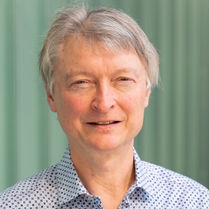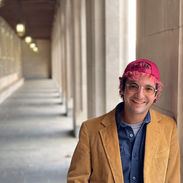
Hugo David Awards
(Previously Paper of the Semester Awards)
The Hugo David Awards are two annual awards for the best papers of the year published by an ESM member. They will be awarded yearly at the annual meeting and the prize is 500 Euros for each of the awardees.
In 2021 the ESM, in collaboration with Hugo David's family, decided to honour this great scientist by creating a new award in his name.
Read more about Hugo David and his work below.
Entry Guidelines
Who is eligible?
-
First or last author of the publication, must be an active and paid member of the society at the time of the proposal and will be the recipient of the prize.
-
First or last author can only be awarded one prize a year.
-
In cases where there are co-first authors, it is sufficient for one of them to be an ESM member.
-
Researchers must be under 40 (or less than 7 years after PHD)
-
Submitted papers must have appeared within 6 months of the deadline, defined as the date of online publication
Proposals and selection process
-
The deadline for submitting publications will be 30 June and 31 December each year and the winner for each semester will be announced within the month following the deadline.
-
Proposals can be submitted via the online application form at www.esmycobacteriology.eu/hugo-david-award-submission. Please include an abstract as a link or PDF copy.
-
The ESM Steering Committee will review the entries.
Hugo David Award Winners 2025
Speeding up drug susceptibility testing in Mycobacterium tuberculosis using RNA biomarkers

From left to right: An Van den Bossche, Pieter-Jan Ceyssens, Margo Maex, Vanessa Mathys, Amandine Sury
Published in eBiomedicine by The Lancet
Amandine Sury ∙ Margo Maex ∙ Alain Baulard ∙ Roby P. Bhattacharyya ∙ Stéphanie Depickère ∙ Deborah T. Hung ∙ Paul Cos ∙ Fadel Sayes ∙ Wafa Frigui ∙ Roland Brosch ∙ Vanessa Mathys ∙ Elizabeth M. Streicher ∙ Frederik De Keersmaeker ∙ Leen Rigouts ∙ Pieter-Jan Ceyssens ∙ An Van den Bossche
Our paper offers a leap forward in TB research by addressing the need for rapid phenotypic drug susceptibility testing (pDST). While DNA-based methods have improved TB diagnostics worldwide, they fundamentally depend on prior pDST data. We developed TRACeR-TB, an RNA-based pDST distinguishing resistant from susceptible strains by measuring transcriptional stress after a 6-hour antibiotic exposure. TRACeR-TB demonstrates higher sensitivity than MGIT for rifampicin and bedaquiline, identifying resistant phenotypes undetected by genotypic methods. While our method has clear diagnostic implications, we believe its power lies in accelerating TB research. Its speed facilitates high-throughput screening of anti-TB compounds or drug-resistant strains. The assay's broad applicability is shown by testing novel drug-boosting compounds and detecting intracellular drug-inflicted stress, supporting hit-to-lead optimization in and ex vivo. As a rapid, mutation-independent platform, TRACeR-TB accelerates the development of new therapeutic strategies and the discovery of resistance mechanisms, offering a complementary DST to bridge existing gaps in TB diagnostics and research..... Read the full paper here >
Hugo David Award Winners 2024
The mycobacterial glycoside hydrolase LamH enables capsular arabinomannan release and stimulates growth

From left to right: Dr Patrick Moynihan (PI), Kamilla Anochshenko, Dr Samuel Benedict, Amar Gudka, Greg Goudge, Suzanna Benn, Dr Aaron Franklin, and Abigail Layton.
Published in nature communications
Aaron Franklin, Vivian C Salgueiro, Abigail J Layton, Rudi Sullivan, Todd Mize, Lucía Vázquez-Iniesta, Samuel T Benedict, Sudagar S Gurcha, Itxaso Anso, Gurdyal S Besra, Manuel Banzhaf, Andrew L Lovering, Spencer J Williams, Marcelo E Guerin, Nichollas E Scott, Rafael Prados-Rosales, Elisabeth C Lowe, Patrick J Moynihan
Mycobacterial glycolipids are important cell envelope structures that drive host-pathogen interactions. Arguably, the most important are lipoarabinomannan (LAM) and its precursor, lipomannan (LM), which are trafficked from the bacterium to the host via unknown mechanisms.... Read the full paper here >
Photo right: Carla Mariner-Llicer
Photo left: Tuberculosis Genomics Unit IBV-CSIC
Published in nature communications
Carla Mariner-Llicer, Galo A. Goig, Manuela Torres-Puente, Sergo Vashakidze, Luis M. Villamayor, Belén Saavedra-Cervera, Edson Mambuque, Iza Khurtsilava, Zaza Avaliani, Alex Rosenthal, Andrei Gabrielian, Marika Shurgaia, Natalia Shubladze, Alberto L. García-Basteiro, Mariana G. López & Iñaki Comas
Culturing and genomic sequencing of Mycobacterium tuberculosis (MTB) from tuberculosis (TB) cases is the basis for many research and clinical applications. The alternative, culture-free sequencing from diagnostic samples, is promising but poses challenges to obtain and analyse the MTB genome..... Read the full paper here >
Hugo David Award Winners 2024
The mycobacterial glycoside hydrolase LamH enables capsular arabinomannan release and stimulates growth

From left to right: Dr Patrick Moynihan (PI), Kamilla Anochshenko, Dr Samuel Benedict, Amar Gudka, Greg Goudge, Suzanna Benn, Dr Aaron Franklin, and Abigail Layton.
Published in nature communications
Aaron Franklin, Vivian C Salgueiro, Abigail J Layton, Rudi Sullivan, Todd Mize, Lucía Vázquez-Iniesta, Samuel T Benedict, Sudagar S Gurcha, Itxaso Anso, Gurdyal S Besra, Manuel Banzhaf, Andrew L Lovering, Spencer J Williams, Marcelo E Guerin, Nichollas E Scott, Rafael Prados-Rosales, Elisabeth C Lowe, Patrick J Moynihan
Mycobacterial glycolipids are important cell envelope structures that drive host-pathogen interactions. Arguably, the most important are lipoarabinomannan (LAM) and its precursor, lipomannan (LM), which are trafficked from the bacterium to the host via unknown mechanisms.... Read the full paper here >
Photo right: Carla Mariner-Llicer
Photo left: Tuberculosis Genomics Unit IBV-CSIC
Published in nature communications
Carla Mariner-Llicer, Galo A. Goig, Manuela Torres-Puente, Sergo Vashakidze, Luis M. Villamayor, Belén Saavedra-Cervera, Edson Mambuque, Iza Khurtsilava, Zaza Avaliani, Alex Rosenthal, Andrei Gabrielian, Marika Shurgaia, Natalia Shubladze, Alberto L. García-Basteiro, Mariana G. López & Iñaki Comas
Culturing and genomic sequencing of Mycobacterium tuberculosis (MTB) from tuberculosis (TB) cases is the basis for many research and clinical applications. The alternative, culture-free sequencing from diagnostic samples, is promising but poses challenges to obtain and analyse the MTB genome..... Read the full paper here >
Hugo David Award Winners 2023
Published in Eurosurveillance
Miguel Martínez-Lirola , Marta Herranz , Sergio Buenestado Serrano, Cristina Rodríguez-Grande, Eva Dominguez Inarra, Jose Antonio Garrido-Cárdenas , Ana María Correa Ruiz , María Pilar Bermúdez , Manuel Causse del Río , Verónica González Galán , Julia Liró Armenteros , Jose María Viudez Martínez , Silvia Vallejo-Godoy, Ana Belén Esteban García, María Teresa Cabezas Fernández , Patricia Muñoz , Laura Pérez Lago, Darío García de Viedma
Mycobacterium caprae is a member of the Mycobacterium tuberculosis complex (MTBC) not routinely identified to species level. It lacks specific clinical features of presentation and may therefore not be identified as the causative agent of tuberculosis. Use of whole genome sequencing (WGS) in the investigation of a family microepidemic of tuberculosis in Almería, Spain, unexpectedly identified the involve- ment of M. caprae. Aim: We aimed to evaluate the pres- ence of additional unidentified M. caprae cases and to determine the magnitude of this occurrence.... Read the full paper here >
Paper of the Semester and Hugo David Winners 2022
Role of Epistasis in Amikacin, Kanamycin, Bedaquiline, and Clofazimine Resistance in Mycobacterium tuberculosis Complex
Published in Antimicrobial Agents and Chemotherapy
Roger Vargas, Jr., Luca Freschi, Andrea Spitaleri, Sabira Tahseen, Ivan Barilar, Stefan Niemann, Paolo Miotto, Daniela Maria Cirillo, Claudio U. Köser, Maha R. Farhat
This study features two notable findings. First, antibiotic resistance to amikacin and kanamycin caused by eis c-14t was lost repeatedly in vivo, presumably owing to the fitness cost in the absence of antibiotic selection, which, to my knowledge, had not been published for MTBC to date. Second and more importantly, Roger made an important contribution to genotypic drug susceptibility testing (gDST). Even though gDST represents the only realistic option for scaling up DST globally, discordant DST results risk undermining the trust of some clinicians in gDST. Specifically, isolates that are found to be genotypically resistant but subsequently test phenotypically susceptible are most problematic. Roger showed that the presence of some mutations can completely counteract the effect of other mutations that would ordinarily confer resistance. Such epistatic interactions have to be considered for individual patient care as well as surveillance, particularly as this phenomenon can be frequent in some settings (e.g. in Lima, Peru, the frequency of bedaquiline and clofazimine resistance would be vastly overestimated if Rv0678 were interpreted without considered the loss-of-function mutations in the associated efflux pump). Indeed, WHO has already announced that analysing the impact of epistasis would be one of the goals of the ongoing work to update to its mutation catalogue for gDST (https://apps.who.int/iris/handle/10665/341981).
Paper of the Quarter and Hugo David Winners 2021
Survival of hypoxia-induced dormancy is not a common feature of all strains of the Mycobacterium tuberculosis complex
Published in Scientific Reports
Barbara Tizzano, Tobias K. Dallenga, Christian Utpatel, Jochen Behrends, Susanne Homolka, ThomasA. Kohl & Stefan Niemann
In this publication, Barbara Tizzano, Tobias Dallenga, Christian Utpatel, and colleagues showed that clinical isolates of not every lineage belonging to the M. tuberculosis complex are able to resuscitate from prolonged periods of oxygen starvation. Previous text book knowledge was that reactivation from dormanxy under hypoxic conditions was a common feature of all strains of the Mycobacterium tuberculosis complex. While all clinical isolates from different sub-lineages of lineage 4 (Euro-American) re-gained ability to proliferate, those belonging to lineage 1 (East African-Indian), lineage 2 (Beijing), and lineage 3 (Delhi/ Central Asian) did not reactivate upon exposure to oxygen in terms of growth, metabolism, and transcription. Transcriptome analysis showed a distinc gene expression program for H37Rb (L4) and Beijing (L2) upon oxygen starvation. These findings could provide deeper understanding in infection dynamics and epidemiology of different lineages of the Mycobacterium tuberculosis complex and may help to develop host-directed therapies and drugs that target the dormant state of mycobacteria.
Hugo Ayres Lopes David: 1932-2007
Hugo L. David was born in 1932 in Mozambique. He earned in 1958, his MD from the Faculty of Medicine at the University of Lisbon, Portugal. After earning his Ph.D. in Microbiology from the University of Wisconsin, USA, in 1969, he joined the Center for Disease Control (CDC) in Atlanta Georgia, USA. Under his supervision protocols for handling mycobacteria specimens, culture, identification and drug susceptibility were established and adopted by the U.S. Department of Health. His research at the CDC focused the Mycobacterium cell wall which is a formidable barrier to antibiotics, and an obstacle to genetic studies.
In 1975, he joined the Pasteur Institute of Paris as a Professor and the Director of the Tuberculosis and Mycobacteria Department. He established a Mycobacterium reference center for identification and drug susceptibility and developed a large collection of mycobacterium strains. He focused the research activity of his students on the construction of a structural and architectural model of the Mycobacterium cell wall, and on the development of the techniques and the tools necessary for the advancement of research in the fields of Mycobacterium genetics and immunology. Among the milestones achieved for the first time in these fields were the description of the Mycobacterium plasmid profile, the isolation of the Mycobacterium plasmid pAL5000 that is the basis of all Mycobacterium shuttle vectors, the identification of the kanamycin gene as a selection marker for mycobacteria, the construction of the first Mycobacterium shuttle vectors pAL12 and pAL32, the use of electroporation to transfer foreign genes into mycobacteria, the establishment of genetic libraries from Mycobacterium species and the demonstration of the expression of Mycobacterium DNA in heterologous systems. These discoveries constituted the foundation for the development of Mycobacterium molecular genetics and renewed a worldwide interest in this far lugging behind field.
Hugo nurtured the exchange of scientific knowledge through the organization of many international conferences focusing on Mycobacterium research, spending months taking part in the organization of mycobacteriology laboratories in other countries, and being one of the founders of the European Society for Mycobacteriology (ESM).
Hugo was remarkably calm in his interactions with others, and simple in his way of living. He listened to his students, motivated them, and created an atmosphere of academic freedom to foster innovation and excellence. He retired from Pasteur Institute of Paris in 1992, with over 200 publications in the field of mycobacteriology.




























